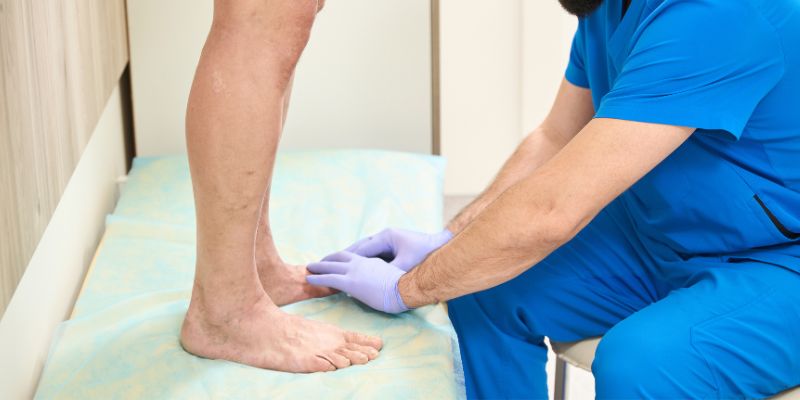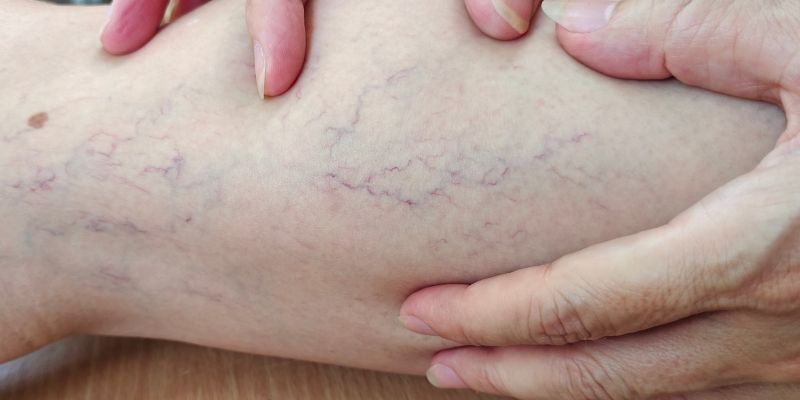Two grave disorders are pulmonary embolism (PE) and deep vein thrombosis (DVT). When a blood clot develops in a deep veintypically in the legDVT results. If the clot separates, it may reach the lungs and produce a pulmonary embolism (PE). Because it restricts lung blood flow, this can be fatal. Venous thromboembolism (VTE), a disorder of blood circulation, affects both DVT and PE.
The clot size will determine whether these disorders cause mild or severe symptoms. The risk factors are surgery, extended immobility, and some medical diseases. Essential is knowledge of the causes, symptoms, and therapies of DVT and PE. Early treatment and diagnosis can help to prevent issues. These disorders, their risk factors, symptoms, and available treatment approaches will be discussed in this article.

What is Deep Vein Thrombosis (DVT)?
A blood clot arising in a deep vein is known as thrombosis. Usually developing in the legs, it can also strike other body areas. Blood thickens into clots that cluster together. These clots might totally or impede blood flow in the impacted vein. When blood flow slows down from immobility, DVT can result. Blood can pool in the veins when the surrounding muscles there stop working.
It increases the likelihood of a clot developing. Long travels, bed rest following surgery, or injuries can all cause this decreased blood flow. Those with some medical disorders, such as heart disease or cancer, also run more chances of DVT. Among other risk factors are smoking, obesity, and using birth control pills. If not addressed early on, the disorder can be fatal.
What is Pulmonary Embolism (PE)?
When a blood clotusually from a DVTtravels to the lungs, pulmonary embolism results. Once within the lungs, the clot might block an artery, limiting or stopping blood flow. This obstruction can cause the lungs to operate improperly, lowering the blood's oxygen content. In a medical emergency, PE calls for quick treatment.
A pulmonary embolism causes shortness of breath, chest discomfort, and a fast heart rate. Some people may also feel lightheaded or cough blood. A big clot might cause death or heart failure, among other major problems. If not treated, even small clots might cause long-term lung difficulties. Reducing the risk of major consequences depends critically on early detection and treatment.
Symptoms of DVT and PE
DVT and PE might present different symptoms. Certain folks might not have any symptoms at all. Common DVT symptoms, however, include:
- Swelling in one leg, usually in the calf
- Pain or tenderness in the leg
- Red or discolored skin
- A warm sensation in the affected area
PE's symptoms are more severe and consist of the following:
- Chest pain that worsens with deep breaths
- Rapid or irregular heartbeat
- Sudden shortness of breath
- Lightheadedness or fainting
- Coughing up blood
If you show any of these symptomsespecially following a period of immobilityyou should visit a doctor immediately.

Risk Factors for DVT and PE
Several things can bring on deep vein thrombosis (DVT) or pulmonary embolism (PE). Every element contributes to either slowing down blood flow or generating conditions favoring the formation of clots. These risk factors comprise:
- Prolonged Immobility: Long stretches of sitting might lower blood flow. Long flights, car rides, or medical-related bedriddenness all limit movement. This inactivity increases the risk of clot formation since blood pools in the legs. Even brief immobility can increase the risk of those with other risk factors.
- Surgery or Injury: Major procedures, particularly those affecting the hips or legs, might raise the risk of blood clots. Damage to blood vessels brought on by surgery might result in the production of clots. Furthermore, patients' limited mobility during recovery contributes to clot risk. Injuries, including fractures and venous damage, also raise the risk of clotting.
- Certain Medical Conditions: Some medical disorders, including cancer, heart disease, and lung disease, might boost clotting tendencies. These diseases could change blood flow or raise the risk of vein inflammation, which can help produce clots. Chronic conditions that restrict mobility can increase the risk even more.
- Hormonal Medications: Medications affecting hormone levels, among other things, can increase the risk of blood clots. Several hormones can influence blood clot formation, increasing the likelihood of clots developing in veins.
- Age: People's DVT and PE risk rises as they get older. Older persons are more prone to limited movement, and their blood vessels weaken with time, increasing their tendency to clot.
- Genetic Factors: DVT or PE is more likely in a family where blood clots run in past generations. Certain individuals inherit genetic disorders that increase their blood's tendency for clotting. These hereditary coagulation abnormalities can greatly increase the risk, particularly when used with other risk factors.
Treatment for DVT and PE
Treatments for DVT and PE seek to stop the clot from getting bigger and lower the risk of fresh clot formation. Typical treatments include:
- Anticoagulants (Blood Thinners): These medications work to prevent fresh clots from developing. They also halt existing clots from proliferating, not dissolving them.
- Thrombolytics: Doctors might dissolve the clot with clot-busting medications in more severe cases. These medications are usually used for big clots blocking lung blood flow.
- Compression Stockings: These help lower edema and stop fresh clots from developing on the legs. They ease pain and aid in increasing blood flow.
- Surgery: Rarely, a big clot could need to be removed by surgery. Usually, one only does this in life-threatening circumstances.
Conclusion:
Serious disorders with potentially fatal results are deep vein thrombosis (DVT) and pulmonary embolism (PE). Preventing and early identification depend on an awareness of the risk factors, symptoms, and available treatments. Intervention and fast medical attention can help to avoid issues and enhance results. Those who keep active, control their medical conditions, and eliminate risk factors will lower their likelihood of DVT and PE development. Quick medical attention should be sought if symptoms arise, particularly following periods of immobility or surgery. Effective management of these threatening diseases depends on early diagnosis and treatment.




